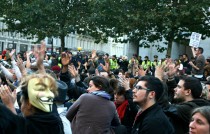How an OL General Assembly works
The facilitator introduces themselves and any co-facilitator, minute taker, time keeper and other members of the facilitation team.
The job of the facilitation team is to ensure the assembly runs smoothly and safely.
Safer Space Policy and hand signals are explained.
The agenda (a list of items to be discussed) is read out, along with a rough allocation of time for each item.
- A proposal is a formal suggestion for the assembly to consider.
- A point is raising your hand to contribute to the discussion. (Points will be heard in the order in which hands were raised and with consideration to time limits. The facilitator can prioritise those who have not already spoken.)
- A clarification is asking a question about something in a proposal that you don’t understand.
- A factual correction is a short point that corrects a fact (not an opinion). [This was previously called a ‘direct point’.]
Not all GAs involve proposals that need testing for consensus, but some do; in these cases:
• Once the proposal has been read, any clarifying questions can be heard.
• A discussion usually follows.
• After discussion the facilitator may ask for a temperature check to gauge how positive the assembly is about the proposal.
• If there is no enthusiasm for the proposal the facilitator may suggest the proposer withdraws it.
• If there is a warm temperature check the facilitator asks if there are any objections.
• If there are no objections the facilitator will test for consensus (agreement).
• If there are objections the facilitator will ask the assembly to hear them.
- An objection might lead to an amendment (alteration) to the proposal; this is referred to as ‘folding in‘ an objection.
• After objections are heard – and folded in if possible – the facilitator will again ask for a temperature check and then, again, will ask if there are objections.
• If objections persist, the facilitator will ask if any of the objectors are willing to stand aside. A stand aside is similar to abstaining. You can stand aside if you don’t agree with the proposal yourself but don’t want to stop the assembly from adopting the proposal. Stand asides are recorded.
• If objectors are willing to stand aside the facilitator will again test for consensus.
• If anyone is not willing to stand aside they will be asked if they intend to block/veto the proposal. A block is a serious matter and implies that the person blocking feels the proposal is against the fundamental principles of the movement [Occupy], to the extent that they would be likely to disengage from the movement if the proposal was adopted.
• A blocker must clearly explain the reasons for their block to the assembly.
- Occasionally the validity of a block may be questioned by someone at the assembly.
- -A block is valid if it can be shown to be in line with Occupy London’s Statements. It is not valid if it contradicts OL Statements. For example, a block that was based on sexism, racism or homophobic sentiments would not be valid. A block must also be focused on the proposal itself, not on the proposer (disliking the proposer is not a valid reason to block).
- -If, after hearing the blockers reasons, someone proposes that the block is invalid, the assembly can be polled. If 10% (or more) of the people present think the block is valid, it will be allowed.
- -In the case of a valid block, the blocker is responsible for contacting the proposer as soon as possible after the assembly to arrange a time and place to attempt to resolve the block, through further discussion and amendments to the proposal.
- -In the event that the blocker does not attempt resolution, the block falls and the proposal can be adopted at a subsequent GA.
- -When a block has been resolved or has fallen, and the proposal returns to an assembly, the whole process does not have to be repeated. Only fresh points that were not raised previously will be considered.




